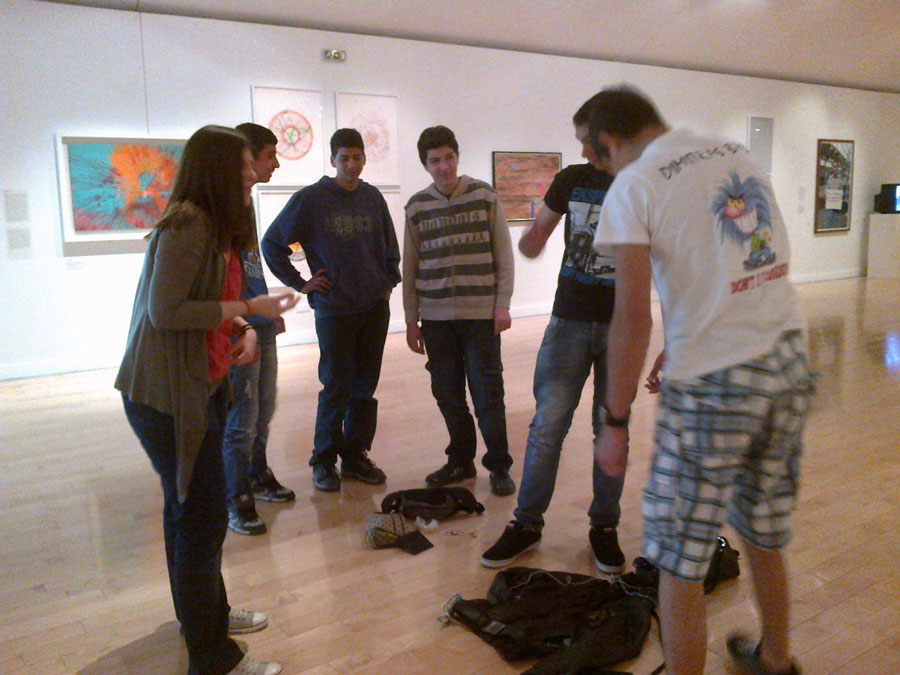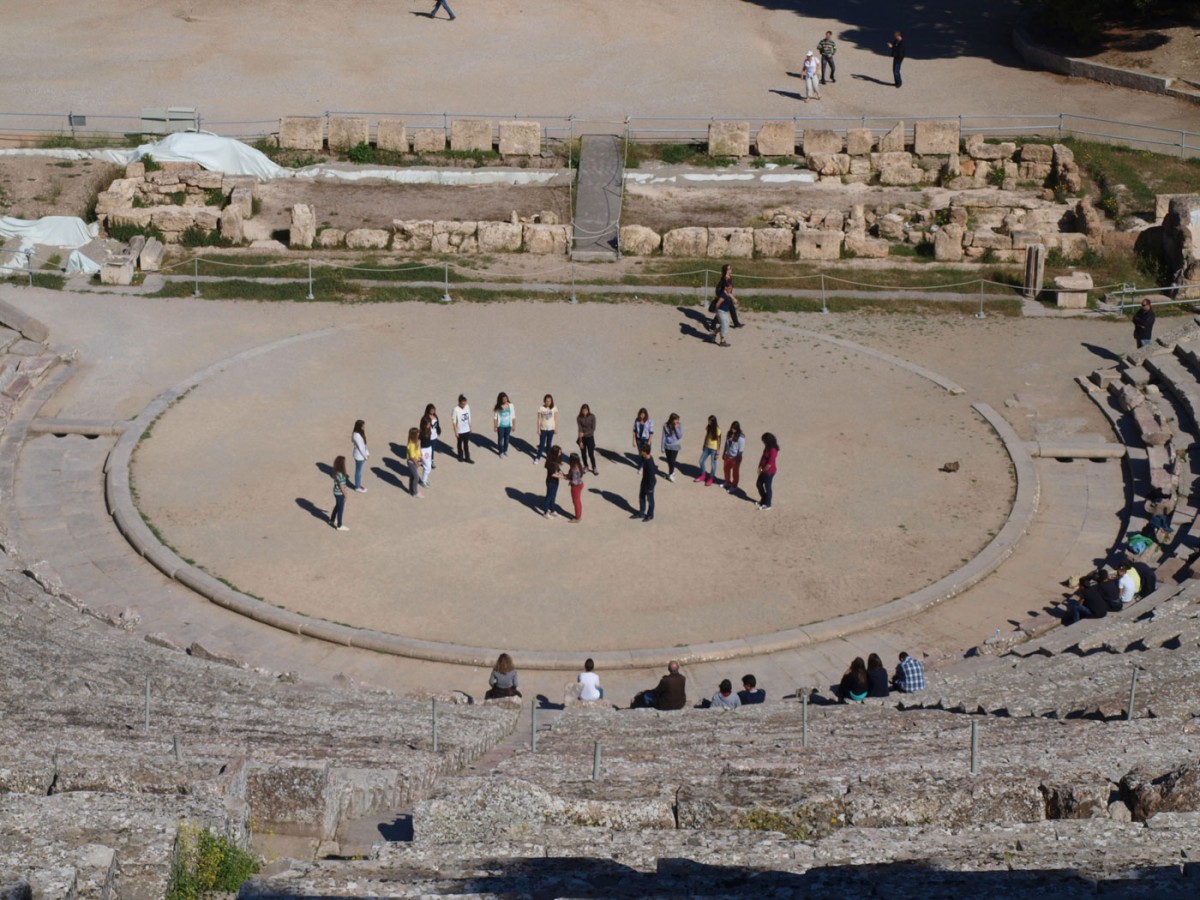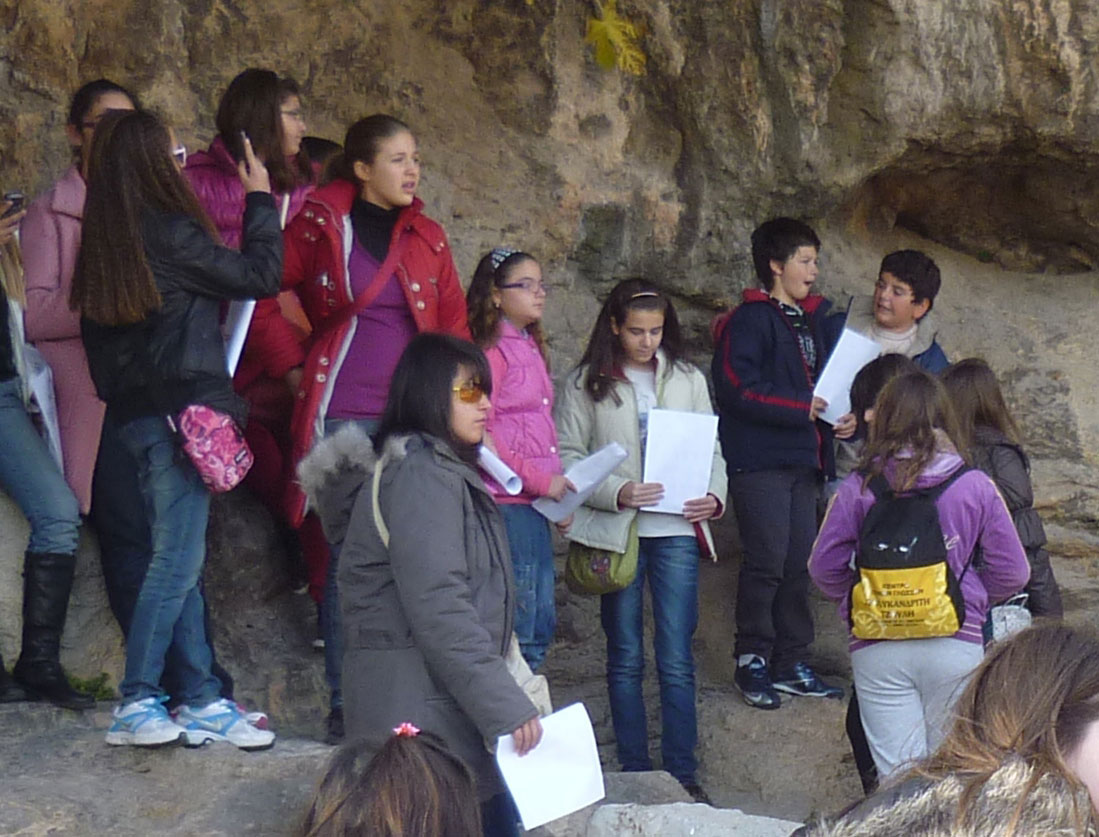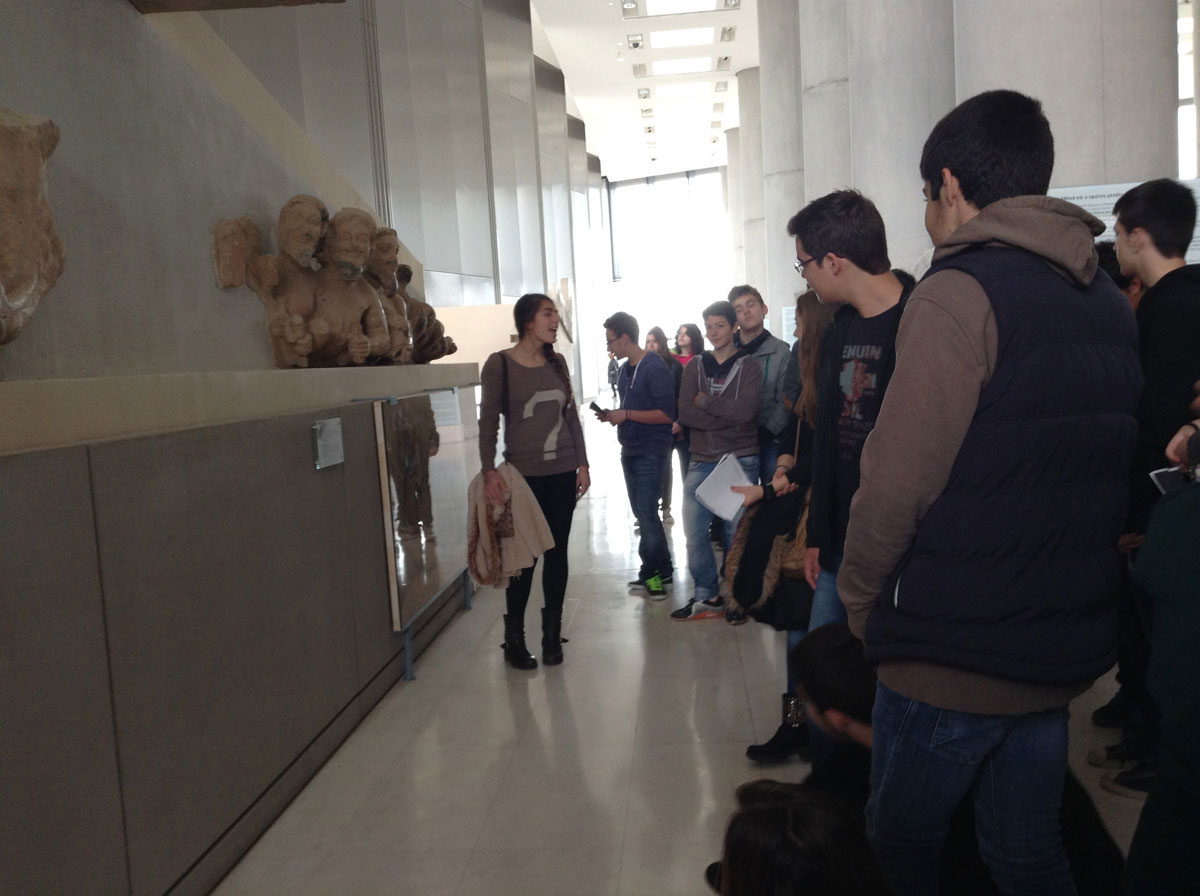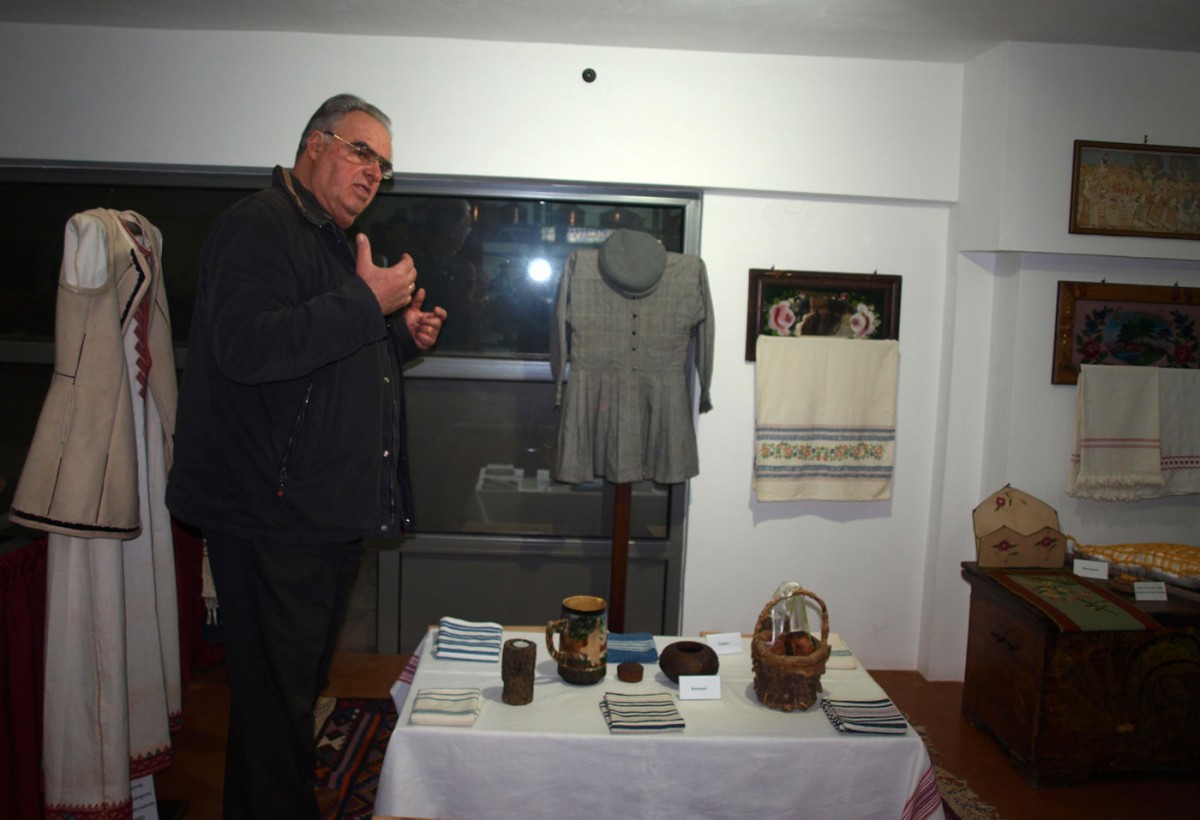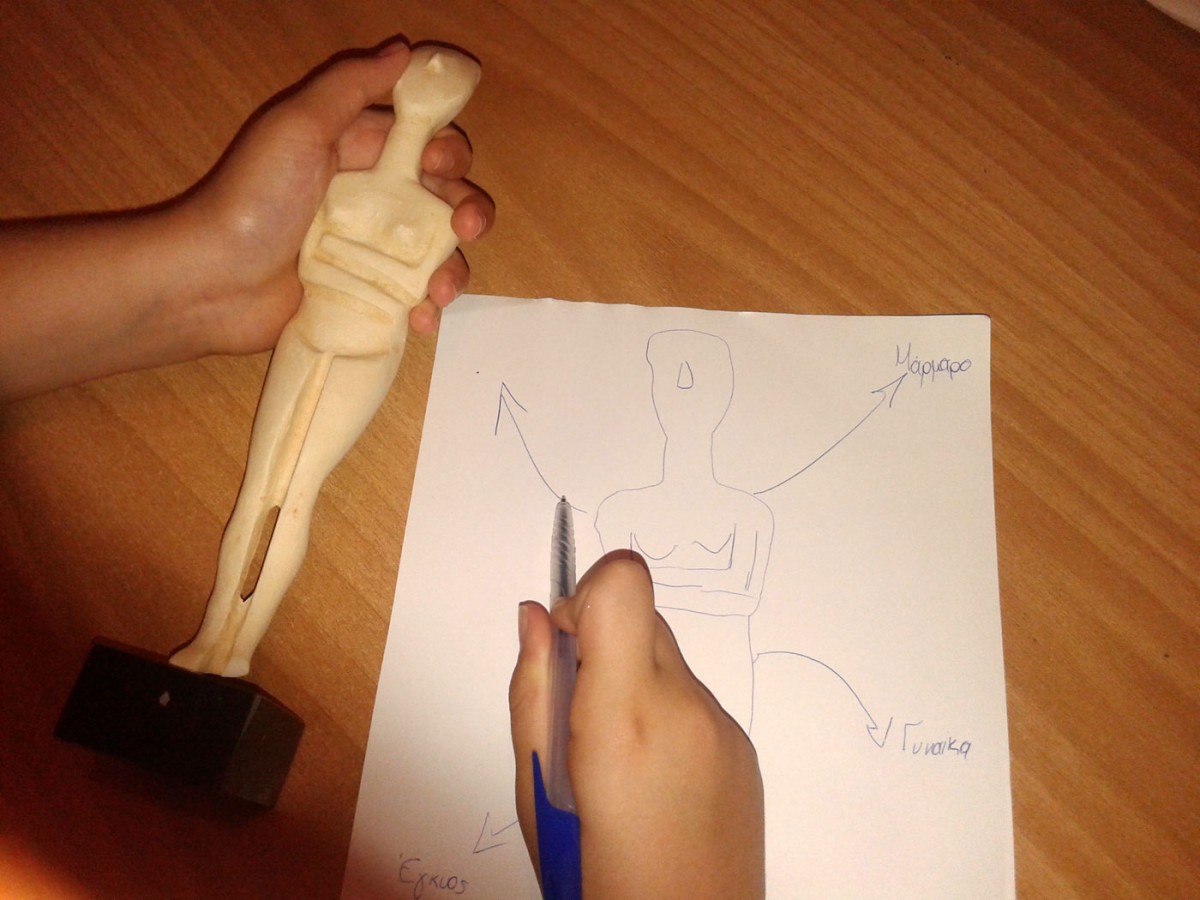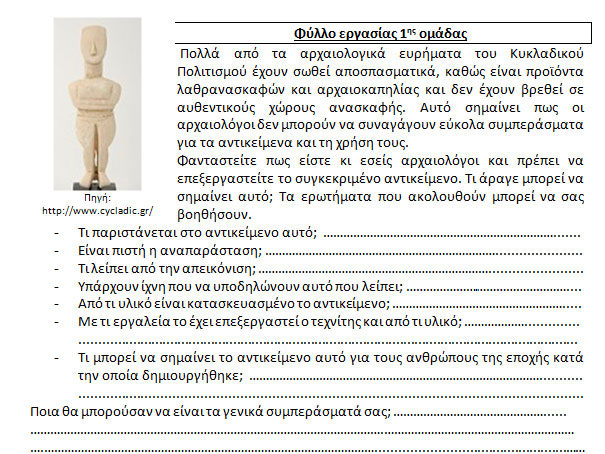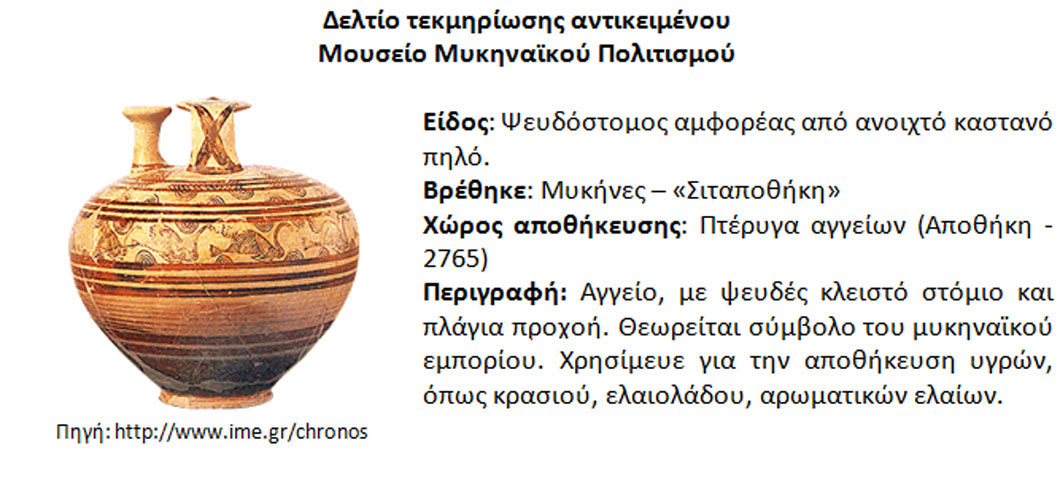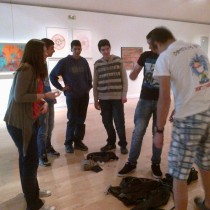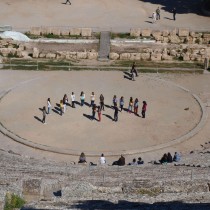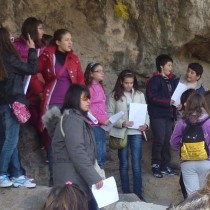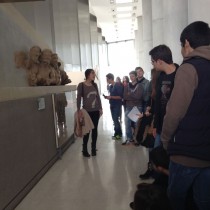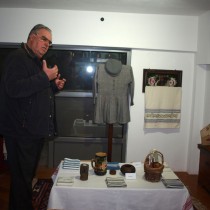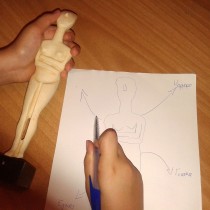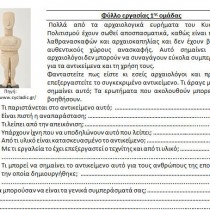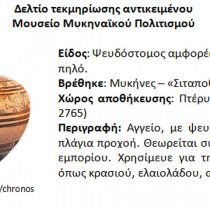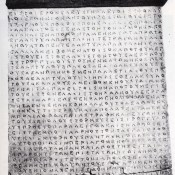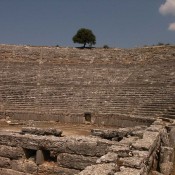As has been generally accepted, museums, archaeological sites and collections are places of learning and offer strong stimuli in understanding life as a timeless phenomenon that starts in the past and whose consequences effect the modern era. This is an important assumption for education, Secondary in particular, since at this level, a great part of the schedule deals with the past.
Over the last years, new quests in the field of education, both in Greece and abroad have led to a redefining of the means and interpretations by which we try to understand and approach the past in schools. The museum, as an alternative learning environment, is often presented in this context as being a natural extension of the classroom, which can contribute in cultivating an interest and understanding of the past. These are key objectives in teaching history and all lessons related to it.
In the present article, a series of teaching scenarios are presented, relating to ways of teaching about the past, that have been realized in practice with Secondary school students in both the museum and the class room. A common standard for comparing the scenarios has been the utilizing of collections and individual objects as stimuli for the interest, study and understanding of the past. It should also be stressed that the proposed scenarios are shaped by schools being orientated towards museums, according to the means and potential a teacher has in and outside a classroom of today and have been implemented by the writer in Secondary schools of Western Attica.
The needs of High school students
High school students cover a broad spectrum of ages with a variety of developmental features. Individuals, at this age, are at a stage of transition both socially, emotionally, intellectually, as they form their own view of the world, their social and individual identity and their special attitude to learning and knowledge. During this period, students learn by observing, but at their own pace and without tolerating pressure (Morris Hargreaves McIntyre 2002, 32).
Teenagers’ developmental features also considerably influence their visits to museums; at this age, children feel in awe of authentic objects and the past these represent, but they also consider museums to be places with dead exhibits where everyone remains silent. On the other hand, they like to interact and feel that their thoughts and collective decisions are taken into account, which makes a visit to a museum without friends uninteresting (fig. 1). Visits are counted as successful when they give students the opportunity to approach the “most boring lessons” such as history, in a creative and entertaining manner (Morris Hargreaves McIntyre 2002, 32-33; Jensen 1999, 112-113).
The museum, the school and the past
Teaching the past in school may be legitimate, recognizing that in students’ education, the role played by history and other related subjects (Moniot 2000, 25-27) is particularly important for the collective social good (Barton & Levstik 2008). In practice, however, it seems that approaching this subject in as active a way as possible is still a serious matter for debate (Αβδελά 1998, 114-126). The proper use of a Museum as a natural place of learning holds a special place in this discussion (Νάκου 2009; Μούλιου 2005; Δάλκος 2000, 86-93; Davis & Gardner, 1999; Hein 1998), as do collections that are seen as stimuli in the quest for knowledge of the past (Νάκου 2001).
“A past that is lacking in tangible remains, seems far too weak to be credible. […] For us to be sure that a past existed, we must see at least a few of its traces” writesLowenthal (1985, 247) and this is what constitutes the essence of the connection between a museum and the past, at least as a school subject. In the search, therefore, for alternative learning environments, not only should we not ignore museums, historical sites and collections, but we should perhaps make them central to the students’ learning, for the past to gradually take on the role it really should have in the thoughts and conscience of young people as future citizens (Νάκου 2009, 109; Κασβίκης & Ανδρέου 2008, 125-133; Μπούνια & Νικονάνου 2008, 85-88; Χρυσουλάκη & Πίνη 2008, 214-216; Νάκου 2000, 12; Αβδελά 1998, 124-125). The following teaching scenarios were structured, implemented and assessed, bearing all the above in mind and are currently proposed in this paper.
Teaching Scenarios
The pedagogical design
A “teaching scenario” means a set of activities designed to be used for teaching and structured as a unified whole that essentially shapes a narrative (Πόλκας & Τουλούμης 2012, 23; Γκίκα 2002, 350-354). The proposed projects are initially based on the constructivist methodology of teaching and specifically Bruner’s discovery learning and the “Problem solving” process according to the principles of heuristic learning (Γιαννακόπουλος 2011, 59; Τσακίρη & Καπετανίδου 2007, 39; Jeffery-Clay 1997; Peterman 1997). The key technique to be implemented is “enriched teaching”, since extra teaching material is used for developing activities and the teacher works on this along the lines of the “educational scenario”, as a “teacher who creates” (Γιαννακόπουλος 2011, 59-60). Important roles in designing the scenarios are played by the following: the museum space as a stimulus and starting point for reflection, the use of the archaeological site for field work or for its original function, the observation and processing of objects (copies of antiquities) and photographs-pictures in worksheets for data analysis and problem solving (Durbin et al. 2003, 4-6), a proper use of New Technologies to extract information, the gathering of aural testimonies (Κωστή 2008), as well as using the Dramatic Arts in Education (Κοντογιάννη 2012; Φραγκή 2011, 169-170; Αυδή & Χατζηγεωργίου 2007; Τσιάρας 2000. Last, the principles of group collaborative teaching (Ματσαγγούρας 2008, 87) are applied in all activities. A prerequisite for the latter is a familiarity with the concept of the museum, its role, the professions related to it as well as its types and functions (Κωστή 2009).
A description of the teaching scenarios
While the museum experience ensures real contact with the collections in the archaeological site or the museum and is a communication practice with multiple educational advantages (Νικονάνου 2010, 84; Κασβίκης & Ανδρέου 2008, 137-138), excessive demands in time and preparation and the usual issues involving the pupils’ transport outside the school unit, often discourage teachers from such efforts. For this reason, plans are proposed at this point, to make good use of collections and objects and simulate the operation of a museum both inside it and an archaeological site, as well as in the class room, as an alternative approach.
Activities in the archaeological site
-1st teaching scenario: Come and play… in the Ancient Greek Theatre
Lesson: Dramatic Poetry in Translation – Third grade of the Gymnasium. Duration: one hour for in class preparation, one morning for research and activity in the actual theatre and one hour for in class presentation.
Location: The Theatre of Epidaurus.
Prerequisite: Contact with the meaning/concept of ancient Greek drama and the elements of the ancient theatre. As part of the programme of innovative activities taking place outside the conventional teaching schedule, a group of students prepares a scene from either Euripides’ Helen or Aristophanes’ Birds, both part of the Third Gymnasium Curriculum. A permit is also required from the 4th Ephorate of Prehistoric and Classical Antiquities to present a short extract from a play in the Epidaurus theatre.
Activity’s description: The students are properly equipped for studying the theatre space of Epidaurus with ground plan sketches,, pencils, note pads, magnifying glasses, cameras and are divided into groups, each responsible for a different task; the “architects”, again divided into smaller sub groups, record the form of the seats, gangways and steps, the “theatre scholars” also divided into smaller sub groups, study the functionality of the orchestra, the stage, the parodoi, the “directors/sound & lighting designers” study the visuals and acoustics. Last, when all the groups have completed their research, the actors’ group presents the scenes they have rehearsed, without costumes or sets (fig. 2).
Next: Back at school, each group briefly presents the findings of its research. The actors comment on their experience of “performing” in an authentic ancient Greek theatre and answer the other students’ questions.
-2nd teaching scenario: Writing the guide book for the archaeological site
Lesson: Local History for the third class of the Gymnasium. A morning on the site, one in class hour of preparation, one for the projects’ composition and one for their presentation.
Location: The archaeological site of Eleusis.
Prerequisites: Screening of a video of the archaeological site of Eleusis and dividing the students into groups.
Activity’s description: The activity starts with the assumption that for the requirements of a museum education programme on the archaeological site of Eleusis, addressed to fourth grade primary school pupils, the museum educator in charge, wants to prepare a suitable guide book for children of that age. He/she then asks the help of the third Gymnasium class of our school for the best possible pedagogical results. The students of the Gymnasium tour the site, divided into groups each of which specializes in a particular theme; the Eleusinian mysteries, masonry and fortifications, Roman architecture, irrigation systems in antiquity, popular archaeology and the site’s evolution over time. The students record their observations by photographing the site (fig. 3).
Next: In the school’s computer lab, the groups make up their material into a single text, intersperse it with photographs and finally shape it into a simple guide for this archaeological site. During the next teaching hour, the material is presented and a discussion follows.
Activities in the museum
-1st teaching scenario: Being guides in the top museum
Lesson: History for the third class of the Gymnasium. Duration: A morning in the museum, as part of a project on touring and the Elgin issue, over a period of three months.
Location: The Acropolis Museum.
Prerequisites: With the exclusive use of New Technologies, students process direct or indirect historical sources on touring and the Elgin issue and their effects on Greek antiquities. After being informed on the exhibits in the new Acropolis Museum, the ways of exhibiting and the museum’s objectives, the students from one section of the third grade chose from the Acropolis Museum website the sections or the exhibits they would like to process, so as to take students from other sections of their class on a guided tour during the school visit. Next, they gather information and create activities for the rest of the students. Based on the students’ choices, the writer of this paper then sets up, in her teacher’s capacity, the route to be followed in the museum.
Activity’s description: In the museum, the teacher simply guides the students according to the route designed and offers information on further questions with the collaboration of the student-guides. The latter’s main work, however, is the “guided tour” and encouraging their peers by questions and proper stimuli to observe the exhibits. Each group of “guides” has created a brief “package” of visual material that it hands out to the rest of the class, who are free to ask questions (fig. 4).
Next: During the teaching hour to follow, the “guides” discuss the experience, while the students from the other sections grade the groups and assess their peers. No one is pronounced a winner, because in a museum… there are no winners or losers.
-2nd teaching scenario: Asking grandfather and grandmother
Lesson: Local History for the third class of the Gymnasium. Duration: A morning spent in the museum, one hour of preparation and one hour for presentation and reflexion.
Location: A local museum, either folklore or archaeological.
Prerequisites: The students are given information about the museum they are going to visit. At the same time, they prepare questions and discuss the principles of contact between the generations and their behaviour with the elderly people that they will meet in the museum. A group of elderly people prepares itself likewise, following an agreement with the town’s old people’s home.
Description of the activity in the museum: the students meet up with the elderly people in the museum. After the necessary introductions, the guided tour begins. In the case of the folklore museum, the elderly become the basic “guides”, discussing the exhibits with the students and relating these to memories recalled from their youth, when asked the right questions (fig. 5). In the case of the archaeological museum, the student groups talk about the “standard” academic type of information on the exhibits and invite the elderly to associate these exhibits with their memories. In both cases, the students record the remarks of the elderly, so as to utilize them in their project.
Next: At school, the students discuss the experience of contact between the generations at the museum and record the resulting material as one piece. After mutual agreement, they decide as to how they will utilize this information.
In class activities
-1st teaching scenario: The scholars of Cycladic Culture
Lesson: History for the first class of the Gymnasium. Duration: Four teaching hours.
Prerequisites – 1st teaching hour: The starting point and the placing in space and time of the Cycladic Civilization and its association with the Bronze Age.
Description of the 1st Activity – 2nd teaching hour: The students are divided into five groups. Each group is given a copy of a Cycladic archaeological find (from a museum shop). Proper directions are given to the students on work sheets, so as work out, from the objects’ treatment, the basic characteristics of the Cycladic civilization, namely the multitude of figurines, the female form in figurines and its symbolism, the wall paintings and the information they give us on the occupations of that time, the relevant professions and the materials used (fig. 6).
In this phase, according to the principle of constructivism, background knowledge is made use of, as students have already been introduced to stone age female figurines, they have talked about the use of natural dyes and about man’s inherent tendency to represent his activities in paintings. The entire class is presented with each group’s conclusions, which are recorded on the blackboard by the teacher, in the form of a brain storm. (For an example of a work sheet see fig. 7).
Description of the 2nd Activity – 3rd-4th teaching hour: The students study indirect historical sources, they search for pictures on the internet and organize an exhibition on the Cycladic civilization choosing both the theme that interests them and the form the exhibition will have (digital, traditional, in class, in a public space etc.). A reflective discussion follows.
-2nd teaching scenario: The objects belonging to a character
Lesson: History for the first Class of the Gymnasium. Duration: Three teaching hours.
Prerequisites – 1st teaching hour: The screening of a documentary that introduces the Mycenaean Civilization and places it at the time of the Bronze Age. A familiarity with the museum professions is also required.
Activity’s description – 2nd and 3rd teaching hour: Divided into groups, the students play the following parts of museum professionals specializing in the Mycenaean Civilization; “archaeologist”, “museologist”, “conservator”, “sketcher”, “teacher of a group”, all of whom must prepare an essay on “Characters of Golden Mycenae”. The exhibition will consist of four sections, each filling a display case with sketches of a personality/ imaginary character of Bronze Age Mycenae as well as objects related to him/her. The characters are namely: king, scribe, priestess, potter. The Head of the Museum has submitted one file on each character, to be picked up by the “specialists” of each group. Every file contains a few facts about this person and a series of bulletins documenting the museum objects to be used in the exhibition. Out of all the bulletins, the students have to choose the objects to be displayed in every case, to write texts, to design the visual material and the actual exhibition for the display case. The designs for the exhibition and the texts are mounted on the class room walls. (See fig. 8 for an example of a documentation bulletin).
Remarks and conclusions
As recorded by the following remarks during the implementation of the above, students respond very positively to activities that involve them in learning in an active way, bring them into contact with real stimuli, allow them to act independently and participate in decision making:
It was very nice that we went to the theatre of Epidaurus and did all these things. For the first time we felt we were doing something very significant. We were in the most important ancient Greek theatre, the most real theatre (sic) and we were playing an ancient tragedy. It was not only like making theatre, but also like a very important lesson. We learned what it means to be in an ancient play in a theatre where our ancestors also acted. I will be able to talk about it to my children, when I take them there.
Girl student from the third class of the Gymnasium – Epidaurus
It is very nice that we had the statues to study like scientists and this helped us understand better by ourselves whatever we found, instead of Miss telling us about it and us being bored. It was nice because we also played and laughed and we had a lesson as well… It was fantastic.
Boy student from the first class of the Gymnasium – Cycladic Civilization
It is better for you to do research and learn, than being told things by others with you listening. You know what you want, you search for it quite a lot and afterwards you feel great because you did it and not the others… And the essay we made was very nice because we made it… Thank you very much
Girl student from the first class of the Gymnasium – Mycenaean Civilization
For the first time I noticed what there is in a museum. Till now whenever we went to a museum I listened to the guide who said all sorts of things and some I understood and some I did not. Now that I had to give a guided tour, I tried a lot to take care of what I would say, for my fellow students to understand me. And, of course, I watched them as well, when they gave a tour. For the first time I saw a museum and I liked it and I think that today I learned how important it is.
Boy student from the third class of the Gymnasium – The Acropolis Museum
Museums, archaeological sites and even the objects that copy authentic expressions of material culture in the class room, have the ability to awaken the students’ interest in the past, as a subject that can be taught. What could be more fertile ground for the understanding of the past and its culture, than the real place in which it developed? How could this become more credible as time that has been lived, if its existence was not recognized through evidence provided by material culture? Moreover, how could the methodology of research used by scientists, historians, museologists and archaeologists become accessible, if not by the use of objects that simulate the formers’ work?
I could not imagine that our grandmothers could know so much about ancient exhibits. O.k., this was not exactly knowledge, but I was very impressed that they lived so much like the ancient Greeks and know so many things. I at least understood that in antiquity people lived like our grandparents and therefore like us as well. They are not just stories written in books.
Girl student from the third class of the Gymnasium- Programme of intergenerational encounter at the local archaeological museum
The archaeological site impressed me and I liked it a lot. I understood everything. It was very nice. I liked following the route of the initiates who go into the Telesterion. I then understood how it was and it was very informative. It was like living it and helped us to feel it a bit (sic).
Boy student from the third class of the Gymnasium – Archaeological site of Eleusis
While I was saying my lines, I felt very proud and moved. I thought about how so many centuries ago, who knows what important people had performed their plays here. And here I was reciting Aristophanes! It was very nice and moving and I think I understood how impressive this theatre is, when I heard my voice so loud and rising high in the air.
Girl student from the third class of the Gymnasium – Epidaurus
Looking at the figurine of this woman with the swollen belly, I understand that her life was difficult and probably more difficult than ours. Perhaps that is why they made a statue of her. She may also have been very important because she brought life into the world.
Boy student from the first class of the Gymnasium – Cycladic Civilization
It was good that it was us who went and found the walls and photographed them and observed them. In this way, we became like archaeologists, I think, that do their jobs. I don’t know if what we wrote was correct, but my group tried a lot (sic) and we succeeded in quite a few things. I hope the other kids agree as well.
Girl student from the third class of the Gymnasium – Archaeological site of Eleusis
Often, dealing theoretically with material culture at school makes students feel uncomfortable, because they have to memorize detailed descriptions of objects and places they have never seen before. Museums, archaeological sites and collections give food for thought, offer experiences and above all proof that the past existed, resembles the present or differs from it but influences it, so, therefore, deserves to be studied. The recording of aural testimonies on the past by the elderly can also contribute to this and is a process that finds fertile ground in the museum and brings about the creative encounter between generations that are very distant in terms of age, namely teenagers and the elderly.
How can I remember by heart so many details about the ancient theatre that we talk about in class? No way… Here we searched, we measured, made notes and… it was fine. I think that I will never forget them. And the acoustics are very characteristic… As if they had microphones. How can we understand these things from the textbook?
Girl student from the third class of the Gymnasium – Epidaurus
I was very moved to see the Caryatids from close up. They were very beautiful and impressive and for the first time I understood how important it is for the one that is in England also to return, so as to be a complete set with the other Caryatids.
Girl student from the third class of the Gymnasium – Acropolis Museum
I couldn’t imagine that the elderly have similar interests with us and that we could collaborate. The information they gave us is very important for the work we have taken on. I was very impressed on how well they knew the museum.
Boy student from the third class of the Gymnasium – Intergenerational programme in the local folklore museum
Epilogue
It is true that the preparation for a school visit to a museum or archaeological site is time consuming and requires bureaucratic procedures on behalf of the school and extra educational work from the teachers ; in fact, complaints are very often made about these visits, using the lost of in class teaching hours as an excuse. And of course, no one could doubt the serious issue related to the cost of transport for the students, especially for those from the more remote areas. This is why activities have also been proposed here that can take place in the class room which, however, cannot wholly substitute contact with the authentic stimuli found in archaeological sites and museums.
It should be emphasized that the activities discussed in this paper have invaluable consequences on the thought and attitude of students towards the past and the lesson itself. If we accept that history and other related subjects are taught in school for the collective good and the gradual shaping of active citizens with a democratic spirit, then we must see that our students’ develop as active a view as possible of the past. Since museums can contribute to this, it is worth our while to experiment.
Katerina Kosti
Secondary School Literature teacher, Museologist (MA, National and Kapodistrian University of Athens)
